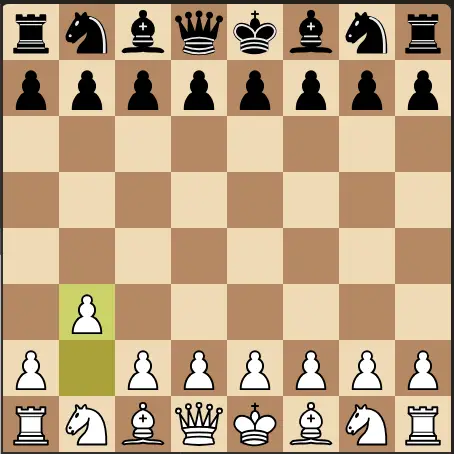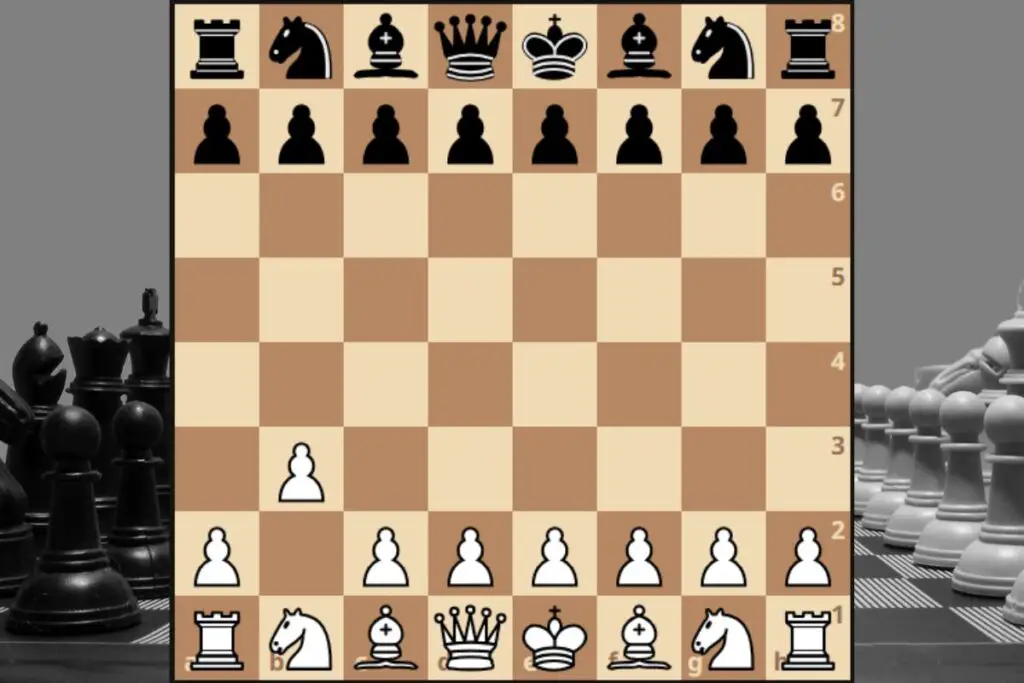The Nimzo Larsen chess opening (1.b3) is alternatively known as the Nimzowitsch-Larsen Attack or the Queen’s Fianchetto Opening, named after its proponents Aron Nimzowitsch and Bent Larsen.

In move 1.b3, the intention is to fianchetto the queen’s bishop to b2. By doing so, the bishop takes control of central squares and exerts influence over Black’s kingside.
This opening exemplifies the hypermodern style, opting to control the center with a bishop instead of a pawn, which is more in line with classical principles. Black has the option to accept the invitation and cover the center with pawns (following classical principles) or mirror the fianchetto idea by fianchettoing their own bishop.
Is the Nimzo Larsen aggressive?
The Nimzo Larnsen is not inherently aggressive in nature. It is considered a flexible and solid opening choice for White, which focuses on controlling the center and developing the pieces harmoniously.
Unlike some aggressive openings that aim to launch immediate attacks on the opponent’s position, the Nimzowitsch-Larsen Opening takes a more restrained approach. By fianchettoing the queen’s bishop to b2, White aims to influence the central squares and put pressure on Black’s kingside without committing to an all-out assault.
The Nimzowitsch-Larsen Opening allows for various setups and transpositions into other openings depending on how Black responds. It can lead to both quiet and positional games or more dynamic and tactical play, depending on the players’ choices.
Overall, while the Nimzowitsch-Larsen Opening provides a decent degree of flexibility, it is not typically considered a highly aggressive opening. Instead, it encourages strategic play, control of the board’s important areas, and potential for long-term advantages.
Is Nimzo-Larsen Good for Beginners?
The Nimzowitsch-Larsen Opening can be a reasonable choice for beginners, but it might not be the most straightforward or recommended option for absolute beginners. Here are some factors to consider:
Simplicity
The opening itself is relatively simple, as it involves fianchettoing the queen’s bishop to b2 and controlling central squares. However, beginners often benefit from learning more basic and fundamental openings before delving into hypermodern or less conventional openings like the Nimzowitsch-Larsen.
Understanding principles
Beginners should focus on understanding fundamental opening principles such as controlling the center, developing minor pieces (knights and bishops) quickly, and ensuring king safety. While the Nimzowitsch-Larsen Opening does control the center, it might not provide the clearest illustration of these principles compared to more classical openings like the Italian Game or the Ruy Lopez.
Common responses
While the Nimzowitsch-Larsen Opening is flexible, opponents may respond in various ways, and beginners might find it challenging to navigate the resulting positions. Understanding how to handle the different responses can be more demanding for beginners compared to studying more common and straightforward openings.
Limited resources
For beginners, it’s essential to focus on a few openings and learn them well. Spending time on too many openings, including the Nimzowitsch-Larsen, might spread their focus too thin and hinder their overall progress.
Considering the above factors, I would generally recommend that beginners start with more traditional and well-established openings that adhere to fundamental principles.
Classical openings like 1.e4 (e.g., the Italian Game) or 1.d4 (e.g., the Queen’s Gambit) are excellent choices for beginners, as they provide a solid foundation and help build a better understanding of chess principles.
As beginners gain experience and confidence, they can explore different openings, including the Nimzowitsch-Larsen, to diversify their repertoire and add flexibility to their game. It’s crucial for beginners to strike a balance between exploring new openings and focusing on building a strong foundation in chess fundamentals.
Black’s Response to the Nimzo Larsen Attack
Here are Black’s responses to 1.b3 (the Nimzowitsch-Larsen Opening):
1… e5 (Modern Variation): The most common response, as it secures the center and limits the scope of the white bishop after 2. Bb2 Nc6.
1… d5 (Classical Variation): Another popular choice, seizing the center and preserving the option to fianchetto the black bishop to g7 to oppose the white one. White can respond with 2. Bb2 or 2. Nf3.
1…Nf6 (Indian Variation): A move preparing to fianchetto the bishop to g7 immediately to challenge the white bishop on b2. However, if Black plays g6 after 2. Bb2, White can play 3. e4! threatening to kick the knight on f6. 3… Nxe4?? loses to 4. Bxh8.
1… c5 (English Variation): Retains the option of 1… d5 while serving as a transpositional tool. 2. e4 transposes into the Sicilian Defense, and 2. c4 transposes into the Symmetrical English. 2. Nf3 is also a viable option.
1… f5 (Dutch Variation): A relatively unexplored alternative. After this move, 2. d4 and 2. Nf3 are the most common responses, although 2. e3 and even 2. e4!? (borrowing ideas from the Staunton Gambit) are both possible.
1… e6: Sets up a variation of the French Defense. White’s most common and recommended response is 2. e4 d5 3. Bb2.
1… c6: Sets up a variation of the Caro-Kann Defense. White’s most common and recommended response is 2. e4 d5 3. Bb2.
1… Nc6: Supports the advance of the e-pawn but allows 2. d4, putting pressure on the knight.
1… b6 (Symmetrical Variation): Black copies White’s idea. This is a valid approach for Black.
1…b5!? (Polish Variation): A fun alternative to the other moves, resulting in unique positions without transpositions.
1…a5!?: Somewhat playable, attempting to disrupt White’s fianchetto, but since White will likely castle on the kingside, this move may not be particularly useful.
Graph Showing Popularity of Nimzo-Larsen over time

Final Thoughts
The Nimzo-Larsen Attack, also known as the Larsen Opening or Queen’s Fianchetto Opening, is a dynamic chess strategy that bears the names of its pioneers, Aron Nimzowitsch and Bent Larsen.
This intriguing opening, initiated by 1.b3, offers a flexible and creative approach to control the center and dictate the game’s flow. Exploring its key variations and potential implications sheds light on the strategic intricacies that both beginners and seasoned players can appreciate.


